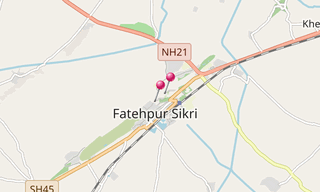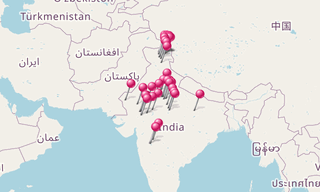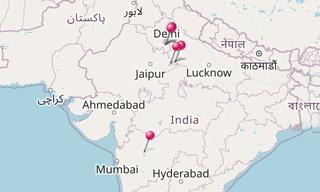Fatehpur Sikri, a city in the state of Uttar Pradesh, was constructed by Mughal Emperor Akbar beginning in 1570 and served as the empire’s capital from 1571 until 1585. It was abandoned after only 14 years because the water supply was unable to sustain the growing population.
Akbar had inherited the Mughal Empire from his father Humayun and grandfather Babur. During the 1560s he rebuilt the Agra Fort and established it as his capital. He had a son and then twins, but the twins died. He then consulted Salim Chishti the Sufi saint who lived as a recluse in the small town Sikri near Agra.
Salim predicted that Akbar would have another son, and indeed one was born in 1569 in Sikri. He was named Salim to honour the saint and would later rule the empire as Emperor Jahangir. The following year, Akbar, then 28 years old, determined to build a palace and royal city in Sikri, to honour Salim Chishti.
Main sights
- Anuuup Talao: A tank with a central platform and four bridges leading up to it.
- Buland Darwaza: One of the gateways to the Jama Masjid.
- Diwan-i-Am: A building typology found in many cities where the ruler meets the general public.
- Diwan-i-Khas: Famous for its central pillar with thirty-six voluted supporting a circular platform for Akbar.
- Hujra-i-Anup Talao: Said to be the residence of Akbar’s Muslim wife, although this is disputed due to its small size.
- Jama Masjid: The mosque, built in the manner of Indian mosques, with liwans around a central courtyard.
- Jodha Bai Palace: The main harem, dominates the harem complex.
- Mariam-uz-Zamani’s Palace: The building of Akbar’s wife shows Gujarati influence.
- Naubat Khana: Near the entry, where important arrivals are announced.
- Pachisi Court: A square marked out as a large sized board game.
- Panch Mahal: A five-storied palatial structure. The bottom floor has 176 intricately carved columns.
- Birbal’s House: The house of Akbar’s favourite minister, who was a Hindu.
- Tomb of Salim Chisti: A white marble encased tomb within the Jama Masjid’s courtyard.

-Diwan-i-Khas.hero.landscape.jpg?w=1600)


-Diwan-i-Khas.jpg?w=256)
-(028)-Tomb-of-Salim-Chisti.jpg?w=256)
-Diwan-i-Khas.jpg?w=256)
-Jodha-Bai-Palast.jpg?w=256)
-(033)-Tomb-of-Salim-Chisti.jpg?w=256)
-Diwan-i-Khas.jpg?w=256)
-Jodha-Bai-Palast.jpg?w=256)
-Jodha-Bai-Palast.jpg?w=256)
-(019)-Tomb-of-Salim-Chisti.jpg?w=256)
-Diwan-i-Khas.jpg?w=256)
-Panch-Mahal.jpg?w=256)
.jpg?w=256)
.jpg?w=256)
-Jodha-Bai-Palast.jpg?w=256)
-Diwan-i-Khas.jpg?w=256)
-(014)-Tomb-of-Salim-Chisti.jpg?w=256)
-(044).jpg?w=256)
-(008)-Tomb-of-Salim-Chisti.jpg?w=256)
-Jodha-Bai-Palast.jpg?w=256)
-Jodha-Bai-Palast.jpg?w=256)
-Panch-Mahal.jpg?w=256)
.jpg?w=256)
.jpg?w=256)
-Diwan-i-Khas.jpg?w=256)
-Panch-Mahal.jpg?w=256)
-Jodha-Bai-Palast.jpg?w=256)
-Panch-Mahal.jpg?w=256)
-(020)-Tomb-of-Salim-Chisti.jpg?w=256)
.jpg?w=256)
.jpg?w=256)
-(027)-Tomb-of-Salim-Chisti.jpg?w=256)
-(035)-Tomb-of-Salim-Chisti.jpg?w=256)
-(022)-Tomb-of-Salim-Chisti.jpg?w=256)
.jpg?w=256)
-Diwan-i-Khas.jpg?w=256)
.jpg?w=256)
.jpg?w=256)
-Jodha-Bai-Palast.jpg?w=256)
-Panch-Mahal.jpg?w=256)
.jpg?w=256)
-(051).jpg?w=256)
-(031)-Tomb-of-Salim-Chisti.jpg?w=256)
-Jodha-Bai-Palast.jpg?w=256)
.jpg?w=256)
-(006)-Tomb-of-Salim-Chisti.jpg?w=256)
-Anuuup-Talao.jpg?w=256)
.hero.jpg?w=320)

.hero.jpg?w=320)

.hero.jpg?w=320)
.map.png)